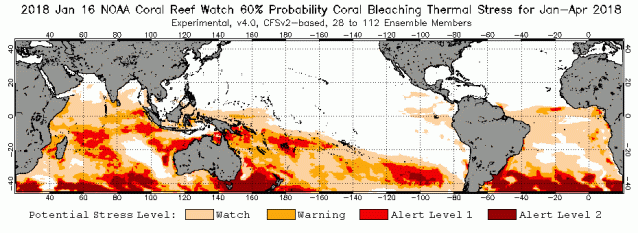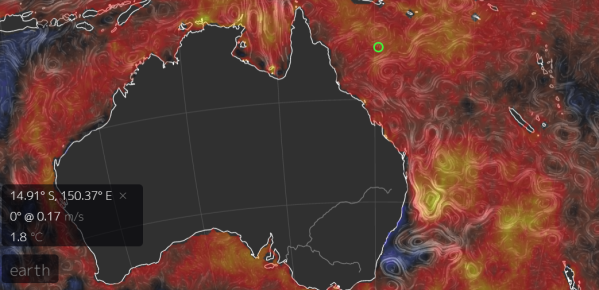2018
to see Third Consecutive Mass Coral Bleaching Event for the Great
Barrier Reef?
22
January, 2018
One
point two degrees Celsius hotter than average (1.2 C). That’s the
temperature threshold where 50 percent of the world’s corals are
likely to die off according
to a scientific study written in Nature during
2013.
The
El Nino year 2016 was
about 1.2 C hotter than 1880s averages.
Meanwhile 2017 was about 1.1 C warmer than normal despite a shift
toward La Nina.
We
are thus entering a very harmful period for the world’s corals. One
in which corals are bleaching and dying off at unprecedented
rates. The
global bleaching event of 2014 through 2017 was the longest lasting
and most damaging in the historical record.
Many reefs around the world suffered severe losses. Reefs that had
never bleached before experienced bleaching and mortality. And this
event included severe damage to the majestic Great Barrier Reef of
Australia.
Bleached
Staghorn corals on Keppel Island Reef during 2016 event that
impacted 93 percent of the Great Barrier Reef. Image source: UNESCO.
Unfortunately,
despite an official end to the 2014 to 2017 global bleaching event,
ocean temperatures across widespread regions remain at thresholds
that are likely to result in stress to corals. And it is arguable
that if bleaching were so widespread as it is now in past decades,
then the present 2018 period would still be considered a global
bleaching event.
Regardless
of how we parse official declarations, reef systems are obviously
still under stress. Just this past week, reports
were coming in that sections of the Great Barrier Reef were bleaching
for the third year in a row.
The bleaching was rather widespread for this time of year. It was
occurring earlier than normal — generating
concern that 2018 bleaching could be worse than expected come
February and March. It
was hoped that the large reef system would be given a bit of respite
from the heat. But
now that particular hope is in doubt.
Corals
around the world are still under threat from extreme ocean heat
despite the fact that the 2014-2017 global coral bleaching event was
officially ended during summer of 2017. Image source: NOAA.
Corals
are one of the many canaries in the climate change coal mine. These
organisms are a vital aspect of global ocean health and the reefs
they build are the
present home for upwards of 2 million species.
Humans depend on corals for the food chains they support and for the
natural beauty they provide. And a global ocean with less corals
provides both less food and support for human beings and for ocean
life as a whole.
Because
corals are so sensitive to temperature change, it is expected that
about 90
percent of the world’s corals will be lost if the Earth warms by
1.5 C.
Meanwhile, virtually all of the corals (more than 95 percent) could
be gone if the world warms by 2 C. With global temperatures at around
the 1.1 C threshold and rising, we are in the danger range for corals
at this time. And the world stands at the brink of losing the
majority of this vital species with the potential to see 90 percent
or more of the world’s corals lost over the next 3 decades under
various scenarios in which fossil fuel burning continues.
Warmer
than normal sea surface temperatures are again threatening
Australia’s Great Barrier Reef (GBR). Jan 15, 2018 sea surface
temperature anomaly image provided by Earth
Nullschool.
Danger
to corals is, today, a very immediate issue. And we are in the period
of risk and damage now. This reality is highlighted by the fact that
what should be a relative respite period for corals is still seeing
abnormally high levels of bleaching.
During
2018, La
Nina in the Eastern Pacific has
generated relatively cooler surface waters in a number of locations.
And we would normally expect La Nina to beat back global coral
bleaching severity. However, an anomalous hot blob of ocean water
between Australia and New Zealand is causing an unusual spike in
ocean temperatures for the zone east of Australia (see image above).
The result is that the GBR is again at risk.
Early
bleaching for the Great Barrier Reef in 2018 is definitely a bad
sign. However, scientists aren’t yet stating that this year will
see bleaching intensity hitting levels similar to 2016 and 2017.
Let’s hope that remains the case. But so long as fossil fuel
burning and related warming continues, the road ahead for corals is
one of existential crisis.






No comments:
Post a Comment
Note: only a member of this blog may post a comment.